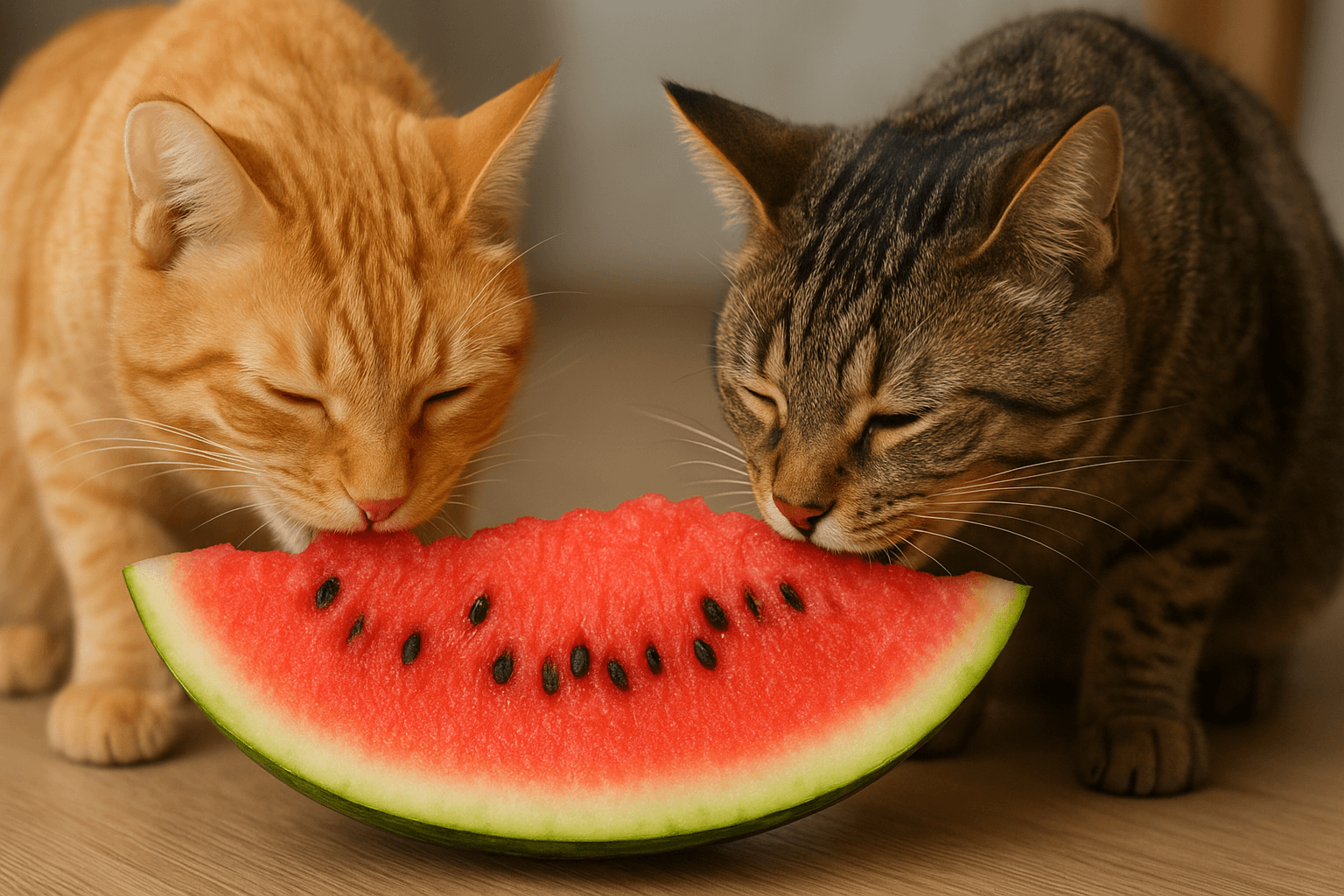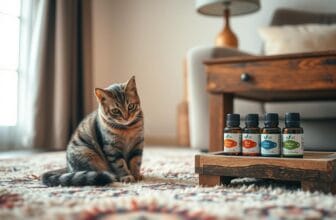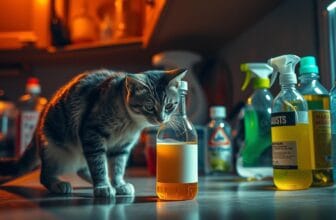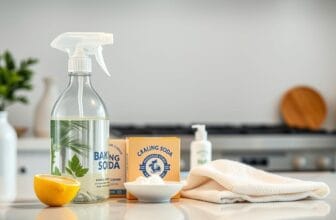
Table of Contents
Did you know some common foods in your kitchen can be deadly for your cat? Many cat owners unknowingly expose their pets to dangerous substances. These can cause serious health risks.
Keeping your cat safe from food poisoning is key. Knowing which foods are toxic can save their life. Every year, thousands of cats face food-related emergencies that could be avoided with the right knowledge.
This guide will show you the most dangerous foods for your cat. You’ll learn about everyday ingredients and surprising toxins. We aim to give you the info you need to keep your cat safe. Our goal is to help you become a more informed pet parent.
Cats have unique digestive systems that make them vulnerable to certain foods. What’s harmless to humans can be dangerous for your cat. By knowing these risks, you can protect your cat’s health and prevent accidents.
Whether you’re new to cat ownership or have been a pet parent for years, this guide is for you. It offers essential insights into cat food safety. This knowledge could save your cat’s life. Let’s explore the critical information every cat owner needs to know.
Understanding Cat Food Safety Basics
Keeping your cat healthy starts with knowing their special needs. Cat food safety is more than just avoiding bad foods. Cats have a unique digestive system that’s very different from ours.
Why Cats Are Sensitive to Human Foods
Cats are very sensitive to some foods because of their special digestive system. Their diet should be different from ours. Here’s why:
- Cats need a lot of protein because they’re meat-eaters
- They can’t digest many human foods
- They’re more likely to get sick from toxins
The Importance of a Species-Appropriate Diet
Cats need a diet that’s just right for them, like their wild ancestors. Domesticated cats still have the genes of their wild relatives. They do best on diets rich in animal proteins and certain amino acids found in meat.
Common Misconceptions About Cat Nutrition
Many pet owners don’t know they’re harming their cat’s health with bad diets. There are many myths about what cats should eat. It’s important to understand what cats really need to stay healthy.
“Cats are not small dogs or miniature humans – they have unique nutritional needs that must be respected.” – Veterinary Nutrition Expert
Chocolate and Caffeine: A Deadly Combination
Pet owners need to know the dangers of chocolate for cats. Chocolate has two harmful substances: theobromine and caffeine. These can be deadly for cats, even in small amounts.
Caffeine poisoning can also happen from other sources. These include:
- Coffee grounds and beans
- Energy drinks
- Tea bags
- Some soft drinks
- Certain medications
The danger from chocolate depends on the type and your cat’s size. Dark chocolate and baking chocolate are the most dangerous because they have more toxins. Milk chocolate is less risky but can still harm your cat.
Symptoms of poisoning in cats include:
- Rapid breathing
- Increased heart rate
- Restlessness
- Muscle tremors
- Vomiting
- Seizures
If you think your cat ate chocolate or caffeinated items, call your vet right away. Quick action is key to avoid serious problems.
Toxic Allium Foods: Onions, Garlic, and Related Plants
Pet owners need to know about dangerous foods for their cats. Allium toxicity is a big health risk many overlook. Foods like onions, garlic, chives, and leeks can harm your cat’s health.
Onion poisoning is very dangerous for cats. These common kitchen items have compounds that can harm your cat’s red blood cells. This can lead to severe anemia.
How Allium Plants Damage Feline Blood Cells
Garlic toxicity comes from chemicals that harm a cat’s red blood cells. Even a little can cause serious health issues. The main risks are:
- Destruction of red blood cells
- Potential development of hemolytic anemia
- Potential long-term health complications
Recognizing Signs of Allium Poisoning
Look out for these warning signs if your cat eats allium foods:
- Weakness or lethargy
- Pale gums
- Rapid breathing
- Vomiting
- Decreased appetite
“Prevention is always better than cure when it comes to your cat’s nutrition.” – Veterinary Nutrition Experts
Safe Alternatives for Flavoring Cat Food
Instead of using allium foods, try these safe options:
- Cooked chicken broth
- Small amounts of bonito flakes
- Cat-specific flavor additives
Always talk to your vet about safe foods for your cat’s needs.
Alcohol and Yeast Dough Dangers
Pet owners need to watch out for alcohol toxicity in cats. Even a little bit of alcohol can be very dangerous. Cats are especially at risk because of their small size.
Yeast dough poisoning is another big danger for cats. Raw dough can harm cats in two main ways. When a cat eats unbaked bread dough, it can face two big risks:
- Alcohol production inside the digestive system
- Dangerous gastric expansion
The yeast in the dough makes alcohol in your cat’s stomach. This can quickly lead to alcohol poisoning. Also, the dough can expand and cause serious bloating or blockage in the intestines.
It’s important to know the signs of alcohol and yeast dough poisoning. Look out for these warning signs:
- Disorientation and unsteady movements
- Depression or extreme lethargy
- Vomiting or retching
- Respiratory difficulties
If you think your cat has had alcohol or raw yeast dough, call your vet right away. Fast action can help avoid serious problems from yeast dough poisoning and alcohol toxicity in cats.
Foods Toxic to Cats: Essential Knowledge for Pet Parents
Cat owners need to watch out for harmful foods that can harm their pets. Knowing how to prevent poisoning is key to keeping your cat safe from dangers in your kitchen.
Spotting poisoning symptoms early is vital for your cat’s health. Cats are very sensitive to many foods and substances that humans think are safe.
Immediate Action Steps for Suspected Poisoning
If you think your cat ate something bad, act fast. Here’s what to do:
- Remove the poison right away
- Call your vet or a pet poison hotline
- Save any evidence of what they ate
- Watch your cat for any signs of trouble
Prevention Tips and Safety Measures
To keep your home safe, follow these steps:
- Keep harmful foods away from your cat
- Teach everyone in the house about dangers
- Lock up chemicals and meds safely
- Use locks and cabinets to keep things safe
Preventing poisoning is always better than treating it after it happens. It’s the best way to protect your cat from harm.
Grapes, Raisins, and Citrus Fruits
Cat owners need to watch out for grape toxicity in cats. These fruits seem harmless but can be very dangerous. Even a small amount can cause serious kidney damage in cats.
Grape toxicity is a big worry for many pet owners. They often don’t realize how risky these fruits are. Cats are very sensitive to grape toxins and can face serious health issues.
- Symptoms of grape toxicity include:
- Vomiting
- Lethargy
- Decreased urine output
- Abdominal pain
Citrus fruits are also a danger. Their essential oils and acids can upset a cat’s stomach and cause skin irritation. The high acid content is especially bad for a cat’s sensitive digestive system.
| Fruit Type | Toxicity Level | Potential Risks |
|---|---|---|
| Grapes | Extremely Toxic | Kidney Failure |
| Raisins | Extremely Toxic | Kidney Damage |
| Citrus Fruits | Moderately Toxic | Digestive Upset |
If you think your cat ate grapes, raisins, or citrus fruits, call your vet right away. The best way to keep your cat safe is to keep these fruits away. Choose safe treats for your cat instead.
Dangerous Nuts and Fat-Rich Foods
Pet owners need to watch what they feed their cats. Some foods, like nuts and high-fat items, can be very harmful. They might even cause serious health problems.
Knowing about macadamia nut toxicity is key. These nuts can harm cats a lot, even if they eat just a little. Eating them can cause many bad symptoms:
- Muscle weakness
- Depression
- Vomiting
- Hyperthermia
- Potential neurological issues
Why Macadamia Nuts Pose a Serious Threat
Macadamia nut toxicity in cats can happen fast. The exact reason is still a mystery. But vets have seen cats get very weak and have trouble with their body temperature soon after eating them.
Pancreatitis Risk from Fatty Foods
High-fat foods are also very dangerous for cats. They can cause pancreatitis, which is an inflammation of the pancreas. This can lead to serious health issues.
| Food Type | Potential Risk | Recommended Action |
|---|---|---|
| Macadamia Nuts | Severe Toxicity | Immediate Veterinary Consultation |
| High-Fat Foods | Pancreatitis Risk | Strict Dietary Management |
Vets say to keep all nuts and high-fat foods away from cats. If you think your cat ate these, call your vet right away. They can give you the best advice.
Raw Meat and Fish Concerns
Feeding your cat a raw diet might seem natural. But, it comes with big risks that pet owners need to know. Raw diet risks for cats include more than just food prep. Bacteria like Salmonella and E. coli can harm your cat from uncooked meats.
Fish also has its own dangers for cats. Raw fish bones can cause choking or serious internal injuries. Some raw fish can also block thiamine absorption, leading to serious health issues.
- Bacterial risks in raw meat include Salmonella and E. coli
- Potential for parasitic infections
- Fish bones can cause serious internal injuries
- Enzyme interference with critical nutrient absorption
Veterinary nutritionists suggest safer options than raw diets. Cooked meats, commercial cat foods, and professional diets offer balanced nutrition without risks.
| Raw Food Type | Primary Risks | Recommended Alternative |
|---|---|---|
| Raw Chicken | Salmonella infection | Cooked, unseasoned chicken |
| Raw Fish | Thiamine deficiency | Commercially prepared fish-based cat food |
| Raw Meat | E. coli contamination | Veterinarian-approved cooked meats |
Always talk to your vet before changing your cat’s diet. This ensures your cat stays healthy and well-nourished.
Dairy Products and Lactose Intolerance
Many cat owners are surprised to learn that most adult cats struggle with lactose intolerance. Kittens can digest milk, but adult cats can’t. This means dairy products can upset their stomachs.

Lactose intolerance in cats is more common than you might think. When cats eat dairy, they can feel very uncomfortable. This can affect their health and happiness.
Understanding Cats’ Digestive Challenges
Cats don’t have enough lactase, the enzyme for lactose breakdown. So, milk and dairy can cause stomach problems:
- Severe stomach cramps
- Diarrhea
- Vomiting
- Bloating
Safe Alternatives to Milk Products
There are great cat-safe dairy alternatives that are nutritious but won’t upset their stomachs. These options help your cat get the nutrients they need without digestive issues.
| Dairy Alternative | Nutritional Benefits | Cat-Friendly Rating |
|---|---|---|
| Lactose-Free Cat Milk | Specially formulated for cats | Excellent |
| Water | Hydration and essential for health | Perfect |
| Bone Broth | Rich in nutrients and minerals | Very Good |
When looking for cat-safe dairy alternatives, talk to your vet. They can help find the best food for your cat’s needs. Every cat is different, and what works for one might not work for another.
Xylitol and Artificial Sweeteners
Artificial sweeteners can be harmful to your cats. Xylitol toxicity is a big worry for pet owners. Cats don’t usually want sweet things, but they can get sick if they eat them.
These sweeteners can cause big problems in cats. They can make cats very sick, even if it’s not obvious right away. Vets say to be very careful with products that have xylitol around pets.
- Common xylitol-containing products to avoid:
- Sugar-free gum
- Dental products
- Baked goods
- Low-calorie snacks
Signs your cat might have eaten xylitol include:
- Sudden weakness
- Vomiting
- Decreased coordination
- Seizures
Prevention is key to keep your cat safe from these dangers. Keep sugar-free items out of reach and watch your pet closely.
Vets say even a little xylitol can be very harmful to cats.
Salt and Seasonings: Hidden Dangers
Salt and seasonings can be harmful to your cat’s diet. Salt toxicity in cats is a serious issue many overlook. Cats have different nutritional needs than humans, making many kitchen ingredients dangerous.
Even a little salt can upset your cat’s health. Cats are very sensitive to sodium. Too much can cause serious problems.
The Impact of Sodium on Feline Health
Salt toxicity in cats can lead to severe health issues. These include:
- Dehydration
- Electrolyte imbalances
- Kidney stress
- Neurological issues
Dangerous Herbs for Cats to Avoid
Some herbs and seasonings are toxic to cats. Here are some to avoid:
- Garlic – Highly toxic to cats
- Onion powder – Can damage red blood cells
- Chives – Potentially harmful in small quantities
- Oregano – May cause digestive issues
Always consult with your veterinarian before introducing any new foods or seasonings to your cat’s diet.
To keep your cat safe, prevent salt and seasoning-related health risks. Check ingredient labels and keep seasonings away from your cat. Choose cat-specific foods and treats that meet their nutritional needs.
Avocados and Other Toxic Fruits

Avocado toxicity in cats is a big concern for pet owners. Avocados have a substance called persin that can harm cats. This fruit might look safe, but it’s actually risky for your cat’s health.
Many fruits are dangerous for cats, not just avocados. Cats have sensitive stomachs, making many fruits toxic. Knowing which fruits to avoid is key to keeping your cat healthy.
- Avocados contain persin, a fungicidal toxin
- The fruit’s skin, pit, and flesh can all be dangerous
- Symptoms of avocado poisoning include vomiting and diarrhea
Cats are very sensitive to some fruits. Cherries with their toxic pits and green tomato parts can be very harmful. Even a little bit of these fruits can cause big problems or worse.
If your cat eats a toxic fruit, watch for these signs:
- Sudden changes in appetite
- Excessive vomiting
- Unusual lethargy
- Difficulty breathing
Always consult your veterinarian immediately if you notice any unusual symptoms after fruit exposure.
There are safe fruits for cats. Small amounts of seedless watermelon can be okay sometimes. But always introduce new foods slowly and in small amounts.
Raw Eggs and Related Risks
Cat owners often wonder if raw eggs are safe for their pets. Raw eggs can be more than just a nutritional issue. They can pose serious health risks that every pet owner should know about.
Feeding cats raw eggs can lead to salmonella risks. This bacteria can cause severe digestive problems and even be life-threatening. Cats with weak immune systems are especially at risk.
- Raw egg whites contain avidin, an enzyme that blocks biotin absorption
- Potential bacterial contamination including Salmonella
- Risk of protein malabsorption
- Potential digestive system complications
Vets say to cook eggs before giving them to cats. Cooking kills harmful bacteria and keeps the good stuff. If you do give eggs to your cat, make sure they’re fully cooked and in small amounts.
| Raw Egg Component | Potential Risk | Recommended Action |
|---|---|---|
| Raw Egg White | Biotin Interference | Cook thoroughly |
| Raw Egg Yolk | Bacterial Contamination | Fully cook before serving |
| Uncooked Egg | Salmonella Exposure | Avoid completely |
Knowing the dangers of raw eggs helps keep your cat safe. Always talk to your vet about what’s best for your cat’s diet.
Emergency Response to Food Poisoning
If your cat gets food poisoning, acting fast is crucial. Knowing the signs and what to do can save your cat’s life.
Spotting food poisoning symptoms early is key. Experts say to watch for these signs:
- Persistent vomiting
- Sudden lethargy
- Unusual weakness
- Dramatic changes in drinking or eating habits
- Visible discomfort or pain
Critical Warning Signs
Some symptoms need immediate veterinary intervention. Look out for these serious signs:
- Seizures or tremors
- Difficulty breathing
- Excessive drooling
- Pale or yellow gums
- Uncontrolled bleeding
Immediate Emergency Steps
Here’s what to do if you think your cat has food poisoning:
- Remove any remaining toxic food
- Do not induce vomiting without professional guidance
- Collect food sample or packaging for identification
- Contact your veterinarian immediately
- Keep your cat calm and comfortable
Your fast action and vet care can greatly help your cat recover from food poisoning.
Prevention Strategies and Safe Food Handling

To keep your cat safe from food dangers, you need to take steps to protect your home. Start by making a safe space for your cat to eat. This means keeping harmful foods out of reach.
By taking the right safety steps, you can lower the risk of your cat getting into dangerous foods. Here are some key steps to follow:
- Install child-proof locks on kitchen cabinets and pantry doors
- Keep toxic foods in sealed containers out of your cat’s reach
- Create a dedicated feeding area away from food preparation zones
- Train family members about safe food handling around cats
Keeping your kitchen safe is very important for your cat’s health. Always clean countertops immediately after meal preparation. Make sure no harmful ingredients are left out. Store dangerous items like chocolate, onions, and alcohol in high, closed cabinets that your cat can’t get to.
Being careful and teaching others is crucial for a safe feeding area. Tell everyone in your home to keep human foods away from your cat. Stick to a routine that keeps your pet safe from harmful foods.
“Prevention is always better than cure when it comes to your cat’s health and nutrition.”
By watching closely and following safe feeding practices, you can keep your cat safe from food dangers.
Conclusion
Understanding cat food safety can be tough, but this guide helps. It teaches you how to keep your cat safe from bad food. Knowing which foods are toxic is key to avoiding poisoning and keeping your cat healthy.
As a pet owner, it’s your job to know about cat food and make smart choices. Every meal is a chance to help your cat stay healthy by avoiding bad foods. Your vet is a great resource for a diet plan that fits your cat’s needs.
Preventing problems is always better than fixing them. Keep dangerous foods away from your cat. Teach your family about food dangers and talk often with your vet. By following this guide, you can make a safe space for your cat to eat well and live long.
Teaching others about cat food safety is important too. Your efforts can help prevent health issues in cats. By knowing and using good cat nutrition, you help make a better world for cats everywhere.
FAQ
What makes certain human foods toxic to cats?
Cats can’t digest many human foods because of their unique body chemistry. Their metabolism is different from ours. Foods that are safe for humans can harm cats, leading to serious health problems.
How quickly can food poisoning affect my cat?
Food poisoning symptoms can show up quickly, from 30 minutes to hours. Look out for vomiting, diarrhea, and lethargy. If your cat shows these signs, get them to the vet fast.
Are all cats equally sensitive to toxic foods?
No, cats vary in how they react to toxic foods. Age, weight, and health play a big role. Young and old cats, and those with health issues, are more at risk.
Can a small amount of a toxic food be safe for my cat?
No, even a little bit of toxic foods like chocolate or grapes can harm your cat. It’s best to avoid these foods altogether. If your cat eats something toxic, call your vet right away.
How can I prevent my cat from accessing toxic foods?
Keep toxic foods away from your cat. Use locks on cabinets and educate your family about safe feeding. Always watch your cat during meals and keep harmful foods out of reach.
What should I do if I suspect my cat has eaten a toxic food?
Call your vet or an animal poison control center right away. Don’t try to make your cat vomit unless a vet tells you to. If you know what your cat ate, tell the vet so they can help.
Are commercial cat foods always safe?
Commercial cat foods are made to meet your cat’s needs. But, always read labels and choose quality brands. Some foods might have bad ingredients. Talk to your vet about the best food for your cat.
Can cats develop food allergies?
Yes, cats can get food allergies just like people. Common allergens include proteins and artificial additives. Look for skin problems, digestive issues, and changes in coat. A vet can help figure out and treat food allergies.







